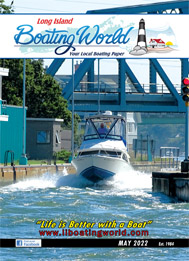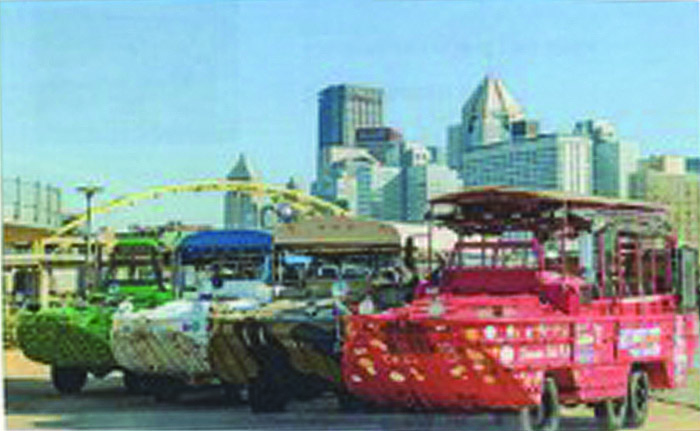
Recreational boats are built for fun, sometimes addressing specific needs. Small, fast boats with unlimited visibility for the captain are needed to safely tow water skiers. Center consoles appeal to fishermen with space allocations that work well with several fishing at one time and a place for bait, lunch, gear and the keeper fish that will make the trip home.
In World War II it was decided that a small amphibious vehicle would fill the need to unload troops and supplies from the big ships a distance from the shore. The amphibious vehicles could be preloaded and on arrival offshore, they would enter the water and navigate to shore by using their rudders and propellers. Once hitting the sand close to the beach, the driver could flip a switch that was handy to him up forward and disengage the propeller and rudder for the tires and front wheel drive to take over. He had the ability to control the air pressure in the tires from where he sat.

Over 20,000 of these amphibious vehicles were manufactured by General Motors for military support. In the 1960s some of these vehicles were still in service. Law enforcement and tour businesses use them today. In 1946 the Original Wisconsin Ducks claim to have started their business as the first tour operator to use retired military duck boats.
The ducks’ official name was DUKW which came from the General Motors Manufacturing Code – D for the year it was designed, U for utility which was amphibious, and the K and W referred to the drive (front wheel) and the dual rear wheels. As they became more commonly used, soldiers called them “ducks.” To keep the design simple GM took their military truck, added a steel hull, propeller, rudder, other mechanicals and bilge pumps to come up with an amphibious winner that helped the US and our allies win World War II.
The 2-1/2-ton 6 x 6 duck boats were powered by straight-six 270 Hp GMC engines and were 31 feet long with an 8 foot 3” beam. Repowered ducks use the small block Chevy engines. Top speed on the road was 50 mph and, in the water, 5.5 knots. The ducks were rated to carry a load of 5,000 pounds of equipment or up to 25 troops.
The ease with which these duck boats sank was always a problem. The boats were not designed to carry heavy weight or travel in heavy seas or strong winds. Many sank during World War II as the user advice from General Motors was ignored. There were buoyancy problems from the beginning that caused capsizing and sinking. When tour operators bought used military duck boats, most of them added a canopy roof and side windows that would retain heat and extend the season. The roof and side windows made it difficult to impossible to escape when the boats capsized and sank. The boats sank quickly and there was very little time to find a way out.
As the tour boats were taken care of mechanically some of the people who worked on them had no idea of the importance of the foam material used for buoyancy and sometimes moved it to reach parts to be serviced. When the foam was not put back where it was intended to be or when it came in contact with moving mechanical parts it resulted in less buoyancy and/or fires. The two accidents in England were due to misplacement of the foam through repair work.
In May of 1999 thirteen died when a duck boat sank on Lake Hamilton in Arkansas. It was determined that the boat did not have the proper buoyancy to stay afloat. In Ontario, in 2002 a custom-built replica duck boat sank in the Ottawa River. Four passengers were trapped under the canopy and drowned. A disabled duck boat was anchored in 2010 on the Delaware River when a tug operator, distracted by use of his cell phone rammed the duck boat, killing two passengers and injuring twenty-five.
In Liverpool, UK, a duck boat with a bad bearing crashed and four passengers were injured. In the UK in 2013 passengers had to jump overboard to escape a fire caused by the replacement of the foam buoyancy that was too close to the mechanicals. In 2015 five were killed and sixteen injured when a duck boat veered into the oncoming lane on a bridge and struck a bus. In 2016 a duck boat killed a woman riding a motor scooter as the duck boat driver turned in his seat to speak to the passengers, acting as a guide while driving the vehicle. Massachusetts legislators passed a law prohibiting duck boat drivers from acting as tour guides and requiring cameras for blind spots on the ducks. In 2018 a duck boat went out just before a predicted thunder storm and capsized in 60 mph winds and rough water. The boat sank and seventeen died.
There have been other duck boat accidents – others killed, others injured – and for the most part, those killed and injured were victims of the capsize and sinking with no way out. The National Transportation Safety Board does not have the authority to force change but for over twenty years has pushed the Coast Guard (who has the authority) to require more buoyancy and to require that the obstructions that hamper escape be removed.
The Branson accident happened when the boat went out after weather reports all day predicted a bad thunderstorm close to the time the boat went out. The boat’s captain was indicted, charging him with seventeen counts of misconduct, negligence and inattention to duty by a ship’s officer, accusing him of failing to adequately assess the weather conditions before setting out. The point was never made that perhaps the captain was following a company culture that valued ticket sales over passenger safety.
There were numerous military accidents with the duck boats as the advice not to overload them or use them in bad weather was ignored by the servicemen. Just days before the end of the war in Europe a duck was bringing ammunition and supplies and troops to northern Italy. Twenty-four American soldiers died when their duck sank in Lake Garda during a storm. Gale force winds should have prevented the vehicle from entering the lake. One soldier survived. The wrecked duck was found more than seventy years later as sonar provided a view of the bottom over 900 feet down.
Since none of the tour operators seemed to think the NTSB warnings were important, none of the tour operators took down the canopies and side windows. There are no reports of any of them changing the buoyancy to measure up to NTSB standards. The Coast Guard didn’t force them to do it so they did nothing. With the resulting death and injury, there is now a law firm that specializes in duck boat death and injury cases. The claims from the numerous accidents have increased the price of insurance to tour operators to a point where it is barely affordable and some tour operators have sold their duck boats and gone out of business. This would be a good time to buy one if you were interested in having something unique, something you could make a career out of fixing. If you like cars and boats it would give you two for the price of one.
So, should you buy a ticket and ride a duck boat to see both sides of a city like Boston? Check it out – if it has the canopy and side windows to keep you warm, these are what will keep you in the duck boat if it sinks and you want to get out. Some of the boats seem to have a canopy and open space where others have windows – think twice, look for a way out and then decide.
